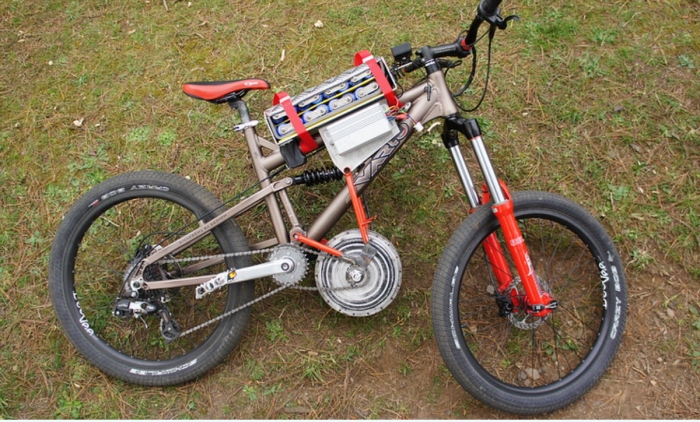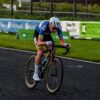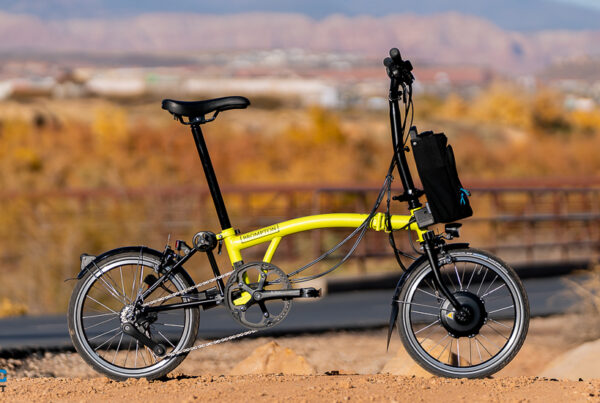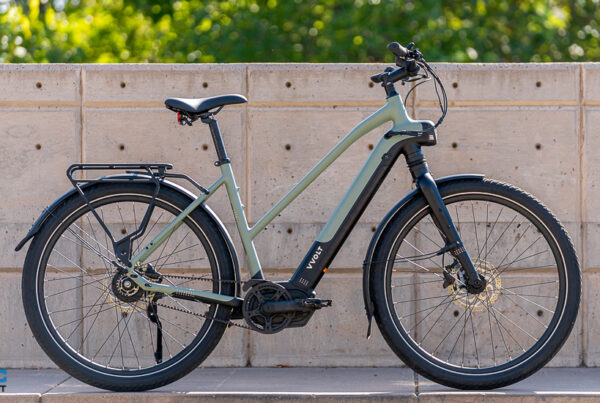A direct drive hubmotor is affordable, simple, and robust. However, they turn at the same low speed as the drive-wheel. Electric motors perform best at higher RPM’s and that is why the most common hubmotors are geared, usually allowing the integrated motor to spin 5 times faster than the wheel. A common 26-inch bicycle wheel is only spinning 336-RPM’s at 26-mph (42 km/h).
Once you mount a hubmotor into the frame and drive the rear wheel with a chain, a whole new world of performance opens up. First, you can easily gear he motor with sprockets to run 2:1 or 3:1 to the rear wheel, with the motor spinning faster than the wheel. Even when only using my preferred 52V, a “high kV” motor (low turn-count) can spin at the new RPM’s to give you the same wheel-speed with higher torque and lower waste-heat. If you don’t have a preference already, I would suggest experiments start with the “Leafbike” 1500W DD hubmotor, because it has the thinner 0.35mm laminations in it’s stator, which results in less eddy-current waste-heat…
Also, to dramatically improve the heat-shedding in a large DD hot rod hubmotor, add 10ml of Ferro fluid (click here), and also (click here).
The second way in which using a DD hubmotor as a non-hub is a major benefit, is that it removes the weight of a large DD hubmotor from the unsprung wheel-weight, and re-mounts it into the frame. This allows the expensive rear suspension of a sophisticated off-road ebike to have a very light and responsive feel to tackling a rough downhill run. A large and powerful rear hubmotor has remained a useful option for street hot rods, but it will always be a compromise for difficult downhill runs.
_____________________________________________
#1. Custom build from Adam, in France
This builder is well-known to us (ES member bzhwindtalker), and he has started a company selling the LMX-64 (Click here). “LMX” means Light Moto Cross.
____________________________________________
#2 Rassy’s 6×10 TerraTrike, from Oregon
When I first saw this build back in 2010, It blew me away. The 6×10 name means that it is a “six turn” winding, using ten strands of copper wire per turn. That’s a reasonably fast winding since he gears it down between the motor and drive-wheel, plus he is driving a smallish 20-inch rear wheel. This results in the trike having a ton of wheel-torque and the motor never seems to get hot, even on steep hills.
“…I easily maintained 8 MPH up the 15% grade…”

The innovative thing about this build is that he runs the motor in reverse (easily done by swapping two of the three motor phase wires), and he drives the rear wheel off of the bottom of the freewheel that is mounted on the hubmotor. Look closely at the pic below. As the rear wheel is spinning in the forward direction, the hubmotor is spinning in reverse (counter-clockwise, as seem from the left side).
This allowed him to mount a conventional freewheel in the standard position on the threaded hubmotor freewheel mount. In the pic below we can see that he is using a 16T heavy-duty White-Industries ENO freewheel. Of course he had to fabricate some custom bracketry to achieve this, but his published pics show a fairly easy way to accomplish that.
There are a variety of ways to achieve the same results, but this arrangement avoids the need for a separate jackshaft between the motor/pedals, and the rear wheel.

For more details, the build-log can be found by clicking here.
____________________________________________
#3 Tench’s Specialized Supercharged Racer
We wrote about this custom build nine years ago in 2012! (for that article, click here). It remains a high water-mark that other builds can aspire to. The builder is endless-sphere forum member “Tench”, and the “Supercharged” name is in response to the weak Specialized “Turbo Levo”. At the time, the Crystalyte Direct Drive (DD) hubmotor with a 35mm wide stator was the most common upgrade to more common “1,000W” hubmotors with a 28mm wide stator.
When mounted in the drop-outs, the Crystalyte was known for breaking the axle from builders who raised the watts of power by using extra volts and amps, and sometimes overheating. Simon is from the UK, and his build used 66V and 40A equalling 2600W, but since it used a high-speed winding and geared it down to a lower RPM, the wheel-torque was off-the-charts.

____________________________________________
#4 Mystery Custom Build

_____________________________________________
#5 Paul Brodie’s eBee from 2013 NAHBS
You can find more details about this build by checking out our article by (clicking here). This build is as custom as it can get. Paul used a CNC to make unique parts that he had drawn up on some paper just a few moments before he started the machine. He didn’t use the largest motor, and he built the battery pack to be as small as possible, then mounted the pack as low as he could get it, seen below as the dark block just in front of the pedal-sprocket.

_____________________________________________
#6 The M55 Terminus
This ebike is no longer available, but for a short time in 2012 it was sold to the public as a VERY expensive option.

_____________________________________________
#7 The “Super V” from John in Costa Rica
Endless-sphere forum member “John in CR” has been a very innovative builder from a long time ago, with this build being posted in 2012.
“…The 28T at the motor 48T at the wheel reduction makes the 9C [motor] effectively running a 12″ wheel so it will be able to climb anything…(ratio 1.7:1)”

_____________________________________________
#8 Fume’s 9C custom build
There are crank-sets that have a sprocket on both sides of the “bottom bracket”, and they are for the “stoker” back-seat position on a tandem 2-seat bicycle. Endless-sphere forum member “Fume” used one of these to allow him to mount a DD hubmotor with the sprocket on the left side. Doing this allowed him to use a freewheel in the usual position.
When doing this, the motor can drive the system through the freewheel, but when unpowered…you can pedal without driving the motor…which could have a small amount of drag from the rim-magnets being attracted to the steel in the stator teeth, which is called “cogging”.
Back in 2013, the “9 continents” / 9C motor was a common DD hubmotor to use. For more details, the build discussion can be found by clicking here.

_____________________________________________
#9 Hannes’ custom mid-drive
This custom build is one of the most professional I have ever seen. The builder is from Austria, and he decided to use a geared hubmotor as a mid-drive. You can find more details in our article by clicking here.

_____________________________________________
# 10 the Cruiser Call
ES member “APL” built this hub-as-a-non-hub cruiser in 2018.

_____________________________________________
#11 The V3 Illegalbike, from Russia
The details of this custom build from Russia can be found by clicking here.

Here is a video of this custom build
_____________________________________________
#12 The APL V4 Dreadnaught
As the name suggests, this is “Version 4” of a street ebike cruiser made by ES member “APL”. A previous version by him can be seem listed above. He named this build the “Dreadnaught” after a battleship from many decades ago, since the high-amp and long-range battery pack weighs 35-lbs! The word “Dreadnaught” means “I fear nothing”…

_____________________________________________
Written by Ron/spinningmagnets, July 2021
Source link








